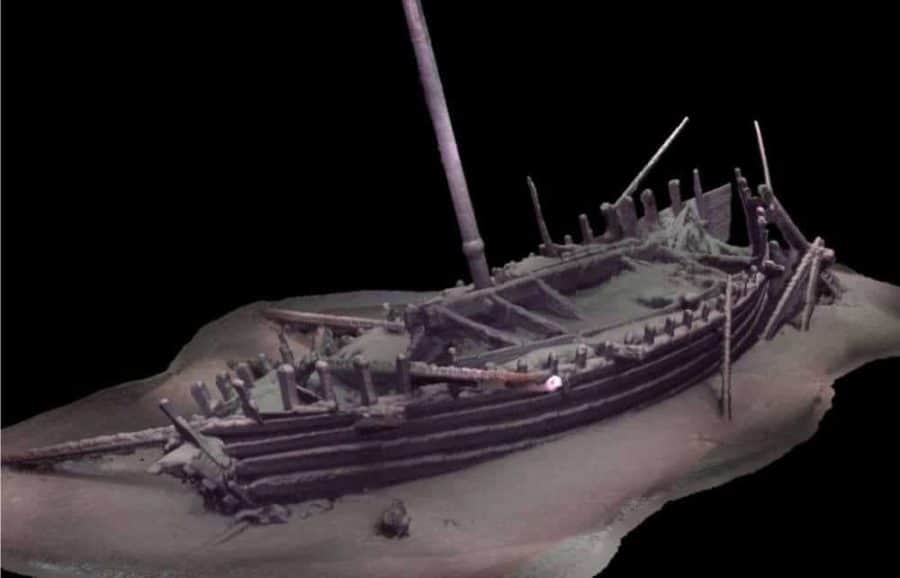Twenty shipwrecks from the 4th and 5th centuries B.C., have been discovered by a team of international scientists, co-directed by a University of Connecticut nautical archaeologist.
The new discoveries bring the total number of wrecks found by the team to more than 60. Recorded with the latest robotic laser scanning, acoustic, and photogrammetric techniques, they represent an unbroken pattern of trade and exchange, warfare, and communication that reaches back into prehistory.
“This is history in the making unfolding before us,” said Kroum Batchvarov, an associate professor of anthropology based at UConn’s Avery Point campus, whose specialty is nautical archaeology. “We have never seen anything like this before.”
Batchvarov is a leader on the three-year Black Sea Maritime Archaeology Project (MAP), described as one of the largest maritime archaeological expeditions ever undertaken.
Since 2015, the team has been investigating the changes in the ancient environment of the Black Sea region, including the impact of sea level change during the last glacial cycle as its primary mission. The announcement of the shipwreck discoveries last fall made headlines worldwide.
The earliest wreck found so far is from the Classical period, from around the 5th to 4th century B.C., said Jonathan Adams, director of the University of Southampton’s Centre for Maritime Archaeology and principal investigator of the scientific team. Ships also have been found from the Roman, Byzantine, and Ottoman periods, spanning two and a half millennia.
“This assemblage must comprise one of the finest underwater museums of ships and seafaring in the world,” he added.
Some of the wrecks have survived in “incredible condition” because of the anoxic conditions of the Black Sea – the lack of oxygen – below a certain depth, Adams says. Ships lie hundreds or thousands of meters deep with their masts still standing, rudders in place, cargoes of amphorae and ship’s fittings lying on deck, with carvings and tool marks as distinct as the day they were made by the shipwrights. Many of the ships show structural features, fittings, and equipment that are only known from iconography or written descriptions but never seen until now.
“The archaeologists are in the role of Sherlock Holmes. We are gathering the clues to figure out what happened,” says Batchvarov. “What we learn about the past, from the past, is applicable to modern times.”
Batchvarov says an entire 2,000-year-old Roman ship found buried in the seabed with its mast, tillers, and rope still intact is “an incredible find, the first of its kind ever.”
The Black Sea MAP is completing its final phase of fieldwork, having excavated the remains of an early Bronze Age settlement at Ropotamo in Bulgaria near the ancient shoreline when the sea level was much lower than today. As the waters rose, the settlement was abandoned, and now the remains of house timbers, hearths, and ceramics lie 2.5 meters below the seabed.
The valley in which the village was located became a sheltered bay visited by Greek colonists of the Archaic period, then a harbor for early Byzantine seafarers, and finally an anchorage used by the Ottomans.
The team has also continued its survey work in deep water up to 50 kilometers offshore using Surveyor Interceptor, a revolutionary remotely operated robotic vehicle, to carry out geophysical surveys along thousands of kilometers, revealing former land surfaces buried deep below the seabed and sampling them by extracting sediment cores up to 12 meters in length.
Filmmakers have documented the discoveries of each voyage, including extraordinary underwater footage of the wrecks, to provide international audiences with unique insight into the history of the Black Sea.
If our reporting has informed or inspired you, please consider making a donation. Every contribution, no matter the size, empowers us to continue delivering accurate, engaging, and trustworthy science and medical news. Independent journalism requires time, effort, and resources—your support ensures we can keep uncovering the stories that matter most to you.
Join us in making knowledge accessible and impactful. Thank you for standing with us!

